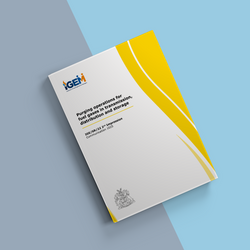IGEM/SR/22 - Purging operations for fuel gases in transmission, distribution and storage

This standard contains guidance on carrying out onshore purging operations (replacement of a gas in a pipeline, vessel or gasholder), designed to prevent the formation of flammable gas mixtures.
These recommendations are intended to provide guidance to those involved in purging operations in the gas industry. They cover onshore purging operations for fuel gases from gas to air and from air to gas, with or without the use of a inert gas, designed to prevent flammable gas mixtures being produced. Specifically, this document contains guidance on purging for the commissioning or decommissioning of pipelines, mains, services, gasholders and vessels, along with the indirect purging of all plants operating with Natural Gas and other fuel gases. It does not cover the purging of underground cavities and Liquefied Natural Gas tanks.
The scope of the standard includes:
- the general principles and methods of purging
- planning of purging operations
- isolation methods
- purging of distribution mains and services
- purging of transmission pipelines
- purging of low pressure gasholders
- purging of vessels (including high pressure gas storage).
Introduction
1.1 These Recommendations are intended to provide guidance to those involved in purging operations in the gas industry.
1.2 The principles, procedures and methods of working outlined in these Recommendations result from many years' experience of this type of operation. The particular requirements for specific applications are detailed in separate sections, whilst general principles apply to purging operations in whatever applications may be involved. In this way, information is presented in a form which accesses each specific application easily, but this information should not be used in isolation from the rest of the document.
1.3 It is now widely accepted that the majority of accidents in industry generally are in some measure attributable to human as well as technical factors, in the sense that actions by people initiated or contributed to the accidents, or people might have acted better to avert them. It is therefore necessary to give proper consideration to the management of these human factors and the control of risk. To assist in this, it is recommended that due cognizance should be taken of the Management of Health and Safety at Work Regulations 1992 for assessing risk and acting on that assessment. In addition, the Health and Safety Executive publication HS(G)65 Successful Health and Safety Management should be consulted.
1.4 These Recommendations do not attempt to make the use of any method or specification obligatory against the judgement of the responsible engineer. Where new and better techniques are developed and proved, they should be adopted without waiting for modification of these Recommendations. Amendments to these Recommendations will be issued when necessary, and their publication will be announced in the Journal of the Institution.
1.5 Requests for interpretation of these Recommendations in relation to matters within their scope, but not precisely covered by the current text, should be addressed to the Secretary, The Institution of Gas Engineers, 21, Portland Place, London, W1N 3AF, and will be submitted to the relevant Committee for consideration and advice, but in the context that the final responsibility is that of the engineer concerned. If any advice is given by or on behalf of the Institution of Gas Engineers, this does not imply acceptance of any liability for the consequences and does not relieve the responsible engineer of any of his or her obligations.
Scope
2.1 These Recommendations cover onshore purging operations for fuel gases from gas to air and from air to gas, with or without the use of inert gas.
2.2 The document gives guidance on purging for the commissioning or decommissioning of pipelines, mains, services, gasholders and vessels.
2.3 The purging of underground cavities and LNG tanks are considered to be specialised operations outside the scope of these Recommendations.
2.4 These Recommendations give detailed advice on the direct purging of Natural gas pipelines, mains and services. They also cover the indirect purging of all plant operating with natural gas and other fuel gases.
2.5 Reference should be made to the Utilization Procedures IGE/UP/1* for installation pipes on industrial and commercial premises.
